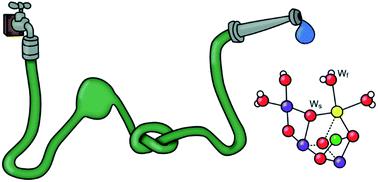当前位置:
X-MOL 学术
›
Chem. Sci.
›
论文详情
Our official English website, www.x-mol.net, welcomes your
feedback! (Note: you will need to create a separate account there.)
The exchange of the fast substrate water in the S2 state of photosystem II is limited by diffusion of bulk water through channels – implications for the water oxidation mechanism
Chemical Science ( IF 7.6 ) Pub Date : 2021-09-01 , DOI: 10.1039/d1sc02265b Casper de Lichtenberg 1, 2 , Christopher J Kim 3 , Petko Chernev 2 , Richard J Debus 3 , Johannes Messinger 1, 2
Chemical Science ( IF 7.6 ) Pub Date : 2021-09-01 , DOI: 10.1039/d1sc02265b Casper de Lichtenberg 1, 2 , Christopher J Kim 3 , Petko Chernev 2 , Richard J Debus 3 , Johannes Messinger 1, 2
Affiliation

|
The molecular oxygen we breathe is produced from water-derived oxygen species bound to the Mn4CaO5 cluster in photosystem II (PSII). Present research points to the central oxo-bridge O5 as the ‘slow exchanging substrate water (Ws)’, while, in the S2 state, the terminal water ligands W2 and W3 are both discussed as the ‘fast exchanging substrate water (Wf)’. A critical point for the assignment of Wf is whether or not its exchange with bulk water is limited by barriers in the channels leading to the Mn4CaO5 cluster. In this study, we measured the rates of H216O/H218O substrate water exchange in the S2 and S3 states of PSII core complexes from wild-type (WT) Synechocystis sp. PCC 6803, and from two mutants, D1-D61A and D1-E189Q, that are expected to alter water access via the Cl1/O4 channels and the O1 channel, respectively. We found that the exchange rates of Wf and Ws were unaffected by the E189Q mutation (O1 channel), but strongly perturbed by the D61A mutation (Cl1/O4 channel). It is concluded that all channels have restrictions limiting the isotopic equilibration of the inner water pool near the Mn4CaO5 cluster, and that D61 participates in one such barrier. In the D61A mutant this barrier is lowered so that Wf exchange occurs more rapidly. This finding removes the main argument against Ca-bound W3 as fast substrate water in the S2 state, namely the indifference of the rate of Wf exchange towards Ca/Sr substitution.
中文翻译:

光系统 II 的 S2 状态下快速底物水的交换受到大量水通过通道扩散的限制——对水氧化机制的影响
我们呼吸的分子氧是由与光系统 II (PSII) 中的 Mn 4 CaO 5簇结合的水源氧物质产生的。目前的研究指出中心氧桥O5为“慢交换底物水(W s )”,而在S 2态下,末端水配体W2和W3都被讨论为“快交换底物水(W s )”。 f )'。 W f分配的一个关键点是它与大量水的交换是否受到通往 Mn 4 CaO 5簇的通道中的障碍的限制。在这项研究中,我们测量了来自野生型(WT)集胞藻的 PSII 核心复合物在 S 2和 S 3状态下 H 2 16 O/H 2 18 O 底物水交换的速率。 PCC 6803 以及两个突变体 D1-D61A 和 D1-E189Q 预计将分别改变通过Cl1/O4 通道和 O1 通道的水进入。我们发现W f和W s的交换率不受E189Q 突变(O1 通道)的影响,但受到D61A 突变(Cl1/O4 通道)的强烈干扰。 结论是所有通道都具有限制Mn 4 CaO 5簇附近的内部水池的同位素平衡的限制,并且D61参与了这样的屏障之一。在 D61A 突变体中,该屏障降低,使得 W f交换发生得更快。这一发现消除了反对Ca结合的W3作为S 2态的快速底物水的主要论点,即W f交换速率对Ca/Sr取代的影响无关。
更新日期:2021-09-06
中文翻译:

光系统 II 的 S2 状态下快速底物水的交换受到大量水通过通道扩散的限制——对水氧化机制的影响
我们呼吸的分子氧是由与光系统 II (PSII) 中的 Mn 4 CaO 5簇结合的水源氧物质产生的。目前的研究指出中心氧桥O5为“慢交换底物水(W s )”,而在S 2态下,末端水配体W2和W3都被讨论为“快交换底物水(W s )”。 f )'。 W f分配的一个关键点是它与大量水的交换是否受到通往 Mn 4 CaO 5簇的通道中的障碍的限制。在这项研究中,我们测量了来自野生型(WT)集胞藻的 PSII 核心复合物在 S 2和 S 3状态下 H 2 16 O/H 2 18 O 底物水交换的速率。 PCC 6803 以及两个突变体 D1-D61A 和 D1-E189Q 预计将分别改变通过Cl1/O4 通道和 O1 通道的水进入。我们发现W f和W s的交换率不受E189Q 突变(O1 通道)的影响,但受到D61A 突变(Cl1/O4 通道)的强烈干扰。 结论是所有通道都具有限制Mn 4 CaO 5簇附近的内部水池的同位素平衡的限制,并且D61参与了这样的屏障之一。在 D61A 突变体中,该屏障降低,使得 W f交换发生得更快。这一发现消除了反对Ca结合的W3作为S 2态的快速底物水的主要论点,即W f交换速率对Ca/Sr取代的影响无关。











































 京公网安备 11010802027423号
京公网安备 11010802027423号